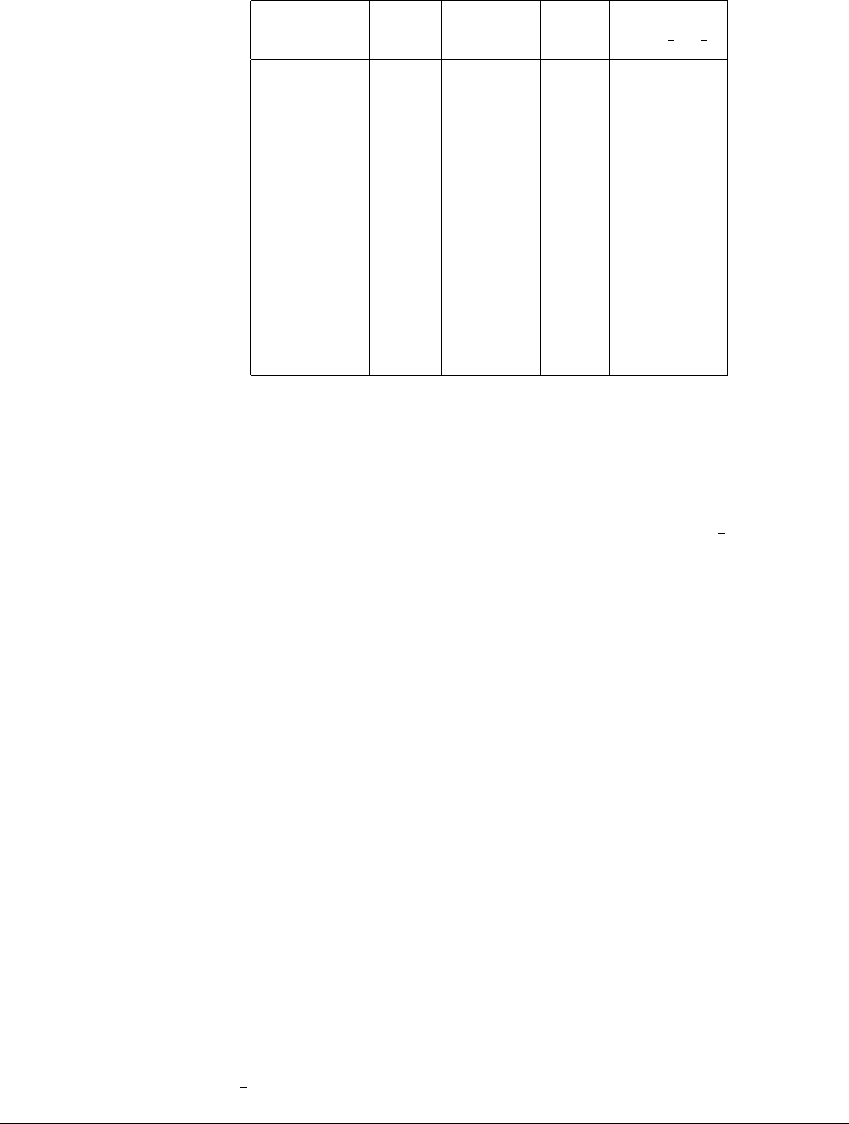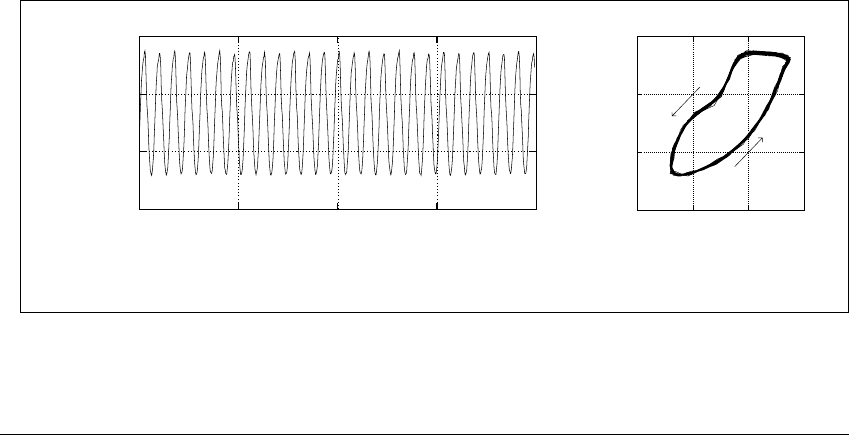Alligood K., Sauer T., Yorke J.A. Chaos: An Introduction to Dynamical Systems
Подождите немного. Документ загружается.


C ASCADES
Window size Period
a
0
R
f
|
R
f
ⴚ
9
4
| (
9
4
)
0.04506988 7 1.226617 1.635 0.27
0.00956120 7 1.299116 2.032 0.097
0.00197090 8 1.121835 2.229 0.0093
0.00084633 9 1.172384 2.245 0.0022
0.00049277 8 1.323307 2.248 0.00097
0.00033056 10 1.176765 2.244 0.0027
0.00032251 15 1.421811 1.637 0.27
0.00030118 9 1.402762 2.249 0.00036
0.00024599 13 1.353915 2.211 0.017
0.00022962 10 1.142882 2.246 0.0018
0.00022952 9 1.293955 2.246 0.0019
Table 12.3 Values of the ratio
R
f
for the H
´
enon map f(
x
1
,x
2
) ⴝ (1 ⴚ
ax
2
1
ⴙ
x
2
,
0
.
3
x
1
)
.
Data is drawn from windows in the range 1.12 ⬍ a ⬍ 1.43 with window widths
greater than 2 ⫻ 10
⫺4
.
for (a, x) near (a
0
,x
0
), where p ⫽ p
1
⫹ p
2
. To be precise, q ⫽
1
2
2
f
x
2
(a
0
,x
0
)
and p ⫽ S
⫺1
f
n
a(a
0
,x
0
).
The rescaling is given by the linear change of coordinates
y ⫽ qS(x ⫺ x
0
),u⫽⫺pqS
2
(a ⫺ a
0
).
In the terminology of the discussion above, the conjugacy H is defined as
H(a, x) ⫽ (u, y) ⫽ (⫺pqS
2
(a ⫺ a
0
),qS(x ⫺ x
0
)).
Step 6 Let g(u, y) be the family of maps conjugate to f
n
(a, x)underthis
change of coordinates. From the expansion for f
n
in Step 5, show that
g(u, y) ⫽ y
2
⫺ u ⫹ O(S
⫺1
(|y|
3
⫹ |y||u| ⫹ |u|
2
)).
Since all cascades of the canonical map take place in a bounded region of (u, y)-
space, say (u, y) 僆 [⫺2.5, 2.5] ⫻ [⫺2.5, 2.5], conclude that g converges to the
canonical map as n →
⬁
.
The universality of the ratio R
g
appears to apply through a wide class
of chaotic systems, including multidimensional systems that contain cascades.
Table 12.3 shows a numerical study of periodic windows for the H
´
enon map
f(x
1
,x
2
) ⫽ (1 ⫺ ax
2
1
⫹ x
2
, 0.3x
1
). The relative error between the calculated R
f
and
9
4
is seen to be typically quite small.
530

E XERCISES
E XERCISES
12.1. Show that there are parameters a
0
and a
c
such that the quadratic family f
a
(x) ⫽
a ⫺ x
2
satisfies Hypotheses 12.7, the hypotheses of the Cascade Theorem.
12.2. Show that neither the quadratic family f
a
(x) ⫽ a ⫺ x
2
nor the logistic family g
a
(x) ⫽
ax(1 ⫺ x) has a period-two saddle node. Show, on the other hand, that each must
have a period-four saddle node.
12.3. Let g
4
(x) ⫽ 4x(1 ⫺ x), and let k be an odd number. Show that half the periodic
orbits of period k are regular repellers and half are flip repellers. Similarly, for a map
that forms a hyperbolic horseshoe, half the periodic orbits of period k are regular
saddles and half are flip saddles. Do the same results hold for any even k?
12.4. Let g denote either the logistic map g
4
or the horseshoe map. Use the following step
to show that for n ⱖ 24, at least 49% of the period n orbits of g are regular unstable
orbits and at least 49% are flip unstable.
(a) Let N be the number of fixed points of g
n
4
that are not period-n points. Show
that the proportion of one type of orbits (flip or regular) is at least
2
n⫺1
⫺N
2
n
⫽
1
2
⫺
N
2
n
. In the remaining two parts we show that
N
2
n
⬍ .01, for n ⱖ 24.
(b) Show that the number N of fixed points of g
n
4
of period less than n is at most
2
n 2
⫹ 2
n 3
⫹ 2
n 4
⫹⭈⭈⭈⫹2 ⱕ n2
n 2
.
(c) Show that the function x2
⫺x 2
is decreasing for x ⬎
2
ln 2
, and that it is less
than .01 for n ⱖ 24.
12.5. Assume that a family of maps f
a
satisfies Hypotheses 12.7 of the Cascade Theorem.
Let p be a periodic orbit of period k at a ⫽ a
c
. Show that each such orbit p is
contained in a connected set of orbits that contains a cascade from period k.
The result follows from the Cascade Theorem if p is a regular unstable orbit.
We assume, therefore, that p is a flip-unstable orbit.
(a) Let G be the following set of orbits: U
⫺
orbits of period k, and U
⫹
and S
orbits of period j, for all j ⱖ 2k. Show that there is a path of orbits of G through
each saddle node of period 2k or higher and through each period-doubling
bifurcation of period k or higher.
(b) Orient the branches of orbits in G to form a new type of “snake”, as follows:
S
→, U
⫹
←,andU
⫺
←. Show that Lemmas 12.10, 12.11, 12.12, 12.13, and
12.14 hold for these snakes to obtain the result. (Don’t forget to show that
period-k stable orbits are contained in the connected set of orbits.)
531

C ASCADES
☞ L AB V ISIT 12
Experimental Cascades
T
HE PERIOD-DOUBLING cascade is perhaps the most easily identifiable route
to chaos for a dynamical system. For this reason, experimental researchers at-
tempting to identify and study chaos in real systems are often drawn to look for
cascades. Here we will survey the findings of laboratories in Lille, France and
Berkeley, California. On the surface, the experiments have little in common—
one involves nonlinear optics, and the other an electrical circuit, but the cascades
that signal a transition to chaos are seen in both.
Scientists at the Laboratoire de Spectroscopie Hertzienne in Lille found period-
doubling cascades in two different laser systems. The first, reported in 1991, was a
CO
2
laser with modulated losses. The laser contains an electro-optic modulator
in the laser cavity, that modulates the amplitude of the laser output intensity.
The alternating current C(t) ⫽ a ⫹ b sin
t applied to the modulator can be
controlled by the experimenter, and various behaviors are found as a, the dc bias,
and b, the modulation amplitude, are varied. The modulation frequency
is fixed
at 640 kHz, the resonance frequency of the device.
Fixing b and using a as a bifurcation parameter yields Figure 12.16 (also
shown as Color Plate 23). The modulation amplitude was set at b ⫽ 3V, and
the dc bias was varied from 60V at the left side of the picture to 460V at the
right side. To make this picture on the oscilloscope, the output intensity of the
laser was sampled 640,000 times per second, the modulation frequency. The
intensity makes a periodic orbit during each sampling period. A single value
branch in Figure 12.16 corresponds to a periodic intensity oscillation in step with
the modulation. The double branch that emanates from the single branch means
that the oscillation takes two periods of the modulation to repeat, and so on.
The orbit with doubled period is often called a subharmonic of the original orbit.
Lepers, C., Legrand, J., and Glorieux, P. 1991. Experimental investigation of the colli-
sion of Feigenbaum cascades in lasers. Physical Review A 43:2573–5.
Bielawski, S., Bouazaoui, M., Derozier, D., and Glorieux, P. 1993. Stabilization and
characterization of unstable steady states in a laser. Physical Review A 47:3276–9.
Kocarev, L., Halle, K. S., Eckert, K., and Chua, L. O. 1993. Experimental observation
of antimonotonicity in Chua’s circuit. Int. J. of Bifurcations and Chaos 3:1051–5.
532

L AB V ISIT 12
Figure 12.16 Period-doubling cascade from a CO
2
laser.
The dc bias of the modulator in the laser cavity is used as a bifurcation parameter, and
is increased from the left side of the diagram to the right. The resulting bifurcation
diagram of laser intensity shows a period-doubling cascade followed by a period-
halving cascade.
Cascades originate from both the right and the left, colliding in the chaotic region
in the middle. The orbits that are created in the initial cascade are systematically
destroyed as the dc bias is further increased, resulting in a reverse cascade.
The same laboratory also produced Figure 12.17, which is a bifurcation
diagram of the power output of an optical-fiber laser. The active medium is a 5-
meter long silica fiber doped with 300 parts per million of trivalent neodymium,
a rare-earth metallic element. The medium is pumped by a laser diode. The input
power provided by the laser diode is the bifurcation parameter. Increasing the
power from 5.5 milliwatts (mW) to 7 mW results in the oscilloscope picture shown
here, which exhibits a period-doubling cascade ending in chaotic behavior for
large values of the power. By adjusting the tilting of the mirrors in this experiment,
various other nonlinear phenomena can be found, including Hopf bifurcations.
533

C ASCADES
Figure 12.17 Period-doubling cascade from an optical-fiber laser.
The pump power is increased from the left of the diagram to the right, resulting in
a bifurcation diagram showing a period-doubling cascade.
L. Chua’s laboratory in Berkeley was the setting for studies of bifurcation
phenomena in Chua’s circuit, which we introduced in Chapter 9. The bifurcation
parameter in this circuit was taken to be the capacitance C
1
across one of the
capacitors. (This parameter is proportional to 1 c
1
in the notation used for the
differential equations (9.6).) Figure 12.18(a) shows the readout of an oscilloscope
screen, exhibiting an experimental cascade as the parameter C
1
ranges from 3.92
nanoFarads (nF) to 4.72 nF. Each vertical division on the screen represents 200
millivolts.
Several different types of periodic and chaotic behavior can be seen in
this picture, including cascades, periodic windows (parameter ranges with only
periodic behavior), bubbles (collisions of cascades from the left and right) and
reverse bubbles (periodic windows with cascades emanating to both left and
right). A magnification of a part of the bifurcation diagram is shown in Figure
12.18(b). At least three odd-period windows are visible in this picture.
534

L AB V ISIT 12
Figure 12.18 Bifurcation diagrams for Chua’s circuit.
Voltage is graphed vertically as a function of the capacitance parameter C
1
.(a)
Period-doubling cascade followed by windows of period 5, 4, 3 and 2. (b) Magnifi-
cation of part of (a).
535

C ASCADES
Experimental bifurcation diagrams from both laboratories show antimono-
tonicity, the destruction of periodic orbits created in a cascade by a reverse
cascade. Although this does not occur for the one-dimensional logistic map, an-
timonotonicity is typical of higher-dimensional systems which contain cascades.
There are many other contributions to the scientific literature demonstrat-
ing period-doubling bifurcations and cascades in laboratory experiments. Many
occurred shortly after Feigenbaum’s published work in 1978.
In 1981, P. Linsay of MIT produced a cascade up to period 16 by varying the
driving voltage in a periodically-driven RLC circuit (Linsay, 1981). His estimate
of the Feigenbaum constant was 4.5 ⫾ 0.6. At about the same time, a group
of Italian researchers (Giglio, Musazzi, and Perini 1981), found a cascade up to
period 16 from a Rayleigh-B
´
enard experiment in a heated chamber filled with
water. Using the temperature gradient as a bifurcation parameter, they estimated
the Feigenbaum constant at approximately 4.3. Cascades were first found in laser
experiments by (Arecchi et al., 1982). Another source with many interesting
examples of cascades and snakes in electronics is (Van Buskirk and Jeffries, 1985),
who studied networks of p-n junctions.
536

C HAPTER T HIRTEEN
State Reconstruction
fro m Da ta
T
HE STATE of a system is a primitive concept that unifies the approach to many
sciences. In this chapter we will describe the way states can be inferred from
experimental measurements. In so doing we will revisit the Belousov-Zhabotinskii
chemistry experiment from Lab Visit 3, the Couette-Taylor physics experiment
from Lab Visit 4, and an example from insect physiology.
13.1 DELAY PLOTS FROM TIME SERIES
Our definition in Chapter 2 was that the state is all information necessary to
tell what the system will do next. For example, the state of a falling projectile
537

S TAT E R ECONSTRUCTION FROM DATA
consists of two numbers. Knowledge of its vertical height and velocity are enough
to predict where the projectile will be one second later.
The states of a periodic motion form a simple closed curve. Figure 13.1(a)
shows a series of velocity measurements at a single point in the Couette-Taylor
experiment, as described in Lab Visit 4. A plot of a system measurement versus
time, as shown in Figure 13.1(a), is called a time series. For these experimental
settings, the system settles into a periodic motion, so the time series of velocity
measurements is periodic.
A useful graphical device in a situation like this is to plot the time series
using delay coordinates. In Figure 13.1(b) we plot each value of the time series
of velocities 兵S
t
其 versus a time-delayed version, by plotting (S
t
,S
t⫺T
) for the fixed
delay T ⫽ 0.03. This is called a delay-coordinate reconstruction, or delay plot.
In Figure 13.1, part (b) is made from part (a) as follows. At each time
t, a point is plotted in part (b) using the two velocities S(t)andS(t ⫺ 0.03).
At time t ⫽ 2, for example, the velocity is decreasing with S(2) ⫽ 800 and
S(1.97) ⫽ 1290. The point (800, 1290) is added to the delay plot. This is repeated
for all t for which recordings of the velocity were made, in this case, every 0.01
time unit. As these delay-coordinate points are plotted, they fit together in a loop
that makes one revolution for each oscillation in the time series.
The interesting feature of a delay plot of periodic dynamics is that it can
reproduce the periodic orbit of the true system state space. If we imagine our
experiment to be ruled by k coupled autonomous differential equations, then the
state space is ⺢
k
. Each vector v represents a possible state of the experiment, and
0
800
1600
2400
0 2 4 6 8
Velocity
time
0
800
1600
2400
0 800 1600 2400
S(t-T)
S(t)
(a) (b)
Figure 13.1 Periodic Couette-Taylor experimental data.
(a) Time series of velocities from the experiment. (b) Delay plot of data from (a),
with time delay T ⫽ 0.03.
538

13.1 DELAY P LOTS FROM T IME S ERIES
by solving the differential equations, the state v(t) moves continuously through
the state space as time progresses.
We can imagine a set of coupled differential equations that governs the
behavior of the Couette-Taylor experiment, but it is not easy to write them
down. The state space dimension k would be very large; perhaps thousands of
differential equations modeling the movement of fluid in small regions might
need to be tracked. This is called “modeling from first principles”. In contrast to
the complicated differential equations of motion, the behavior we see in Figure
13.1 is fairly simple. Periodic motion means that trajectories trace out a one-
dimensional curve of states through ⺢
k
.
Of course, the idea of a real experiment being “governed” by a set of
equations is a fiction. The Couette-Taylor experiment is composed of metal, glass,
fluid, an electric motor, and many other things, but not equations. Yet science has
been built largely on the success of mathematical models for real-world processes.
A set of differential equations, or a map, may model the process closely enough
to achieve useful goals.
Fundamental understanding of a scientific process can be achieved by build-
ing a dynamical model from first principles. In the case of Couette-Taylor, the basic
principles include the equations of fluid flow between concentric cylinders, which
are far from completely understood on a fundamental level. The best differential
equation approximation for a general fluid flow is afforded by the Navier-Stokes
equations, whose solutions are known only approximately. In fact, at present it
has not been proved that solutions exist for all time for Navier-Stokes.
Can we answer questions about the dynamics of the system without un-
derstanding all details of the first principles equations? Suppose we would like
to do time series prediction, for example. The problem is the following: Given
information about the time series of velocity at the present time t ⫽ 2, predict the
velocity at some time in the future, say 0.5 time units ahead. What information
about the present system configuration do we need? Formally speaking, we need
to know the state—by definition, that is the information needed to tell the system
what to do next. But we don’t even know the dimension of the state space, let
alone what the differential equations are and how to solve them. To do time
series prediction, we will use the method of analogues. That means we will try
to identify what state the system is in, look to the past for similar states, and see
what ensued at those times.
How do we identify the present state at t ⫽ 2? Knowing that S(2) ⫽ 800
is not quite enough information. According to the time series Figure 13.1(a),
the velocity is 800 at two separate times; once when the velocity is decreasing,
and once when it is increasing. If we look 0.5 time units into the future from
the times that S ⫽ 800, we will get two quite different answers. We need a way
539
